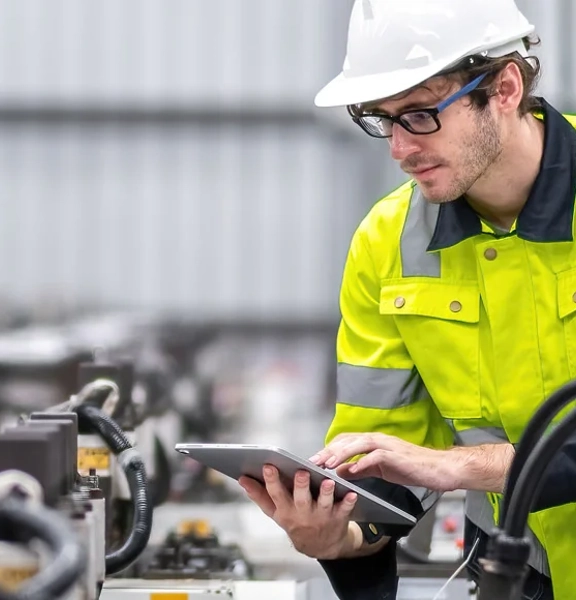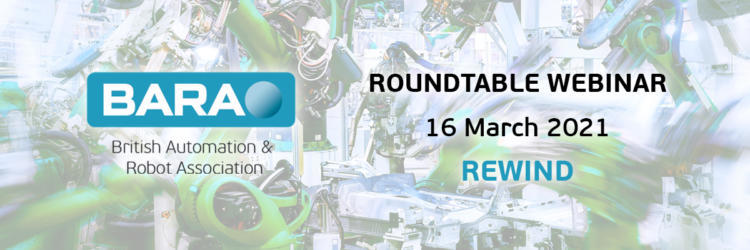Become a member
Take advantage of exclusive member benefits, world class events, networking and specialist support








 Become a member
Become a member 

With robots becoming increasingly popular within the manufacturing sector, especially collaborative robots (‘Cobots’), a panel of BARA representatives and industry experts delved into the real Safety Benefits of Robots for Dangerous Tasks and Environments to help keep workers out of harm’s way.

You can now watch the full video of the BARA Roundtable below. A list of audience Qs&As is now available below.
If you have any additional questions regarding this virtual roundtable or about future events, please email marketing@automate-uk.com
This was a very well executed webinar, the content was specific and the speakers were very knowledgeable in their areas. It was great to have all that expertise in one place.
Shane Ferris, COBOTS.A very informative and enjoyable round table webinar delivered by industry expert speakers who provided many valuable points within their discussions. Time well spent, thank you.
Royce Power, RS Power Ltd.This was a highly informative and useful seminar that is worth listening to.
Nanoo Patel, Tiara Machines and Systems.Subject covered with extensive detail. Speakers provided concise responses with evident knowledge of the subject matter. Host kept the audience engaged throughout.
Mike Whiting, Newmac Ltd.Interesting discussion all round. Questions were answered very concisely.
Steven Marrow, Sponmech Safety Systems.
Charlotte Stonestreet is an experienced business and technology editor in the automation sector. In her current role, Charlotte heads up Controls, Drives & Automation magazine – a highly regarded publication providing insights for key decision makers, buyers and specifiers looking for products, solutions, technical and best practice advice in the areas of motion engineering, power transmission, automation, Industry 4.0 and digitisation.

Adam is an owner and Director of Olympus Technologies, an experienced robot and cobot integrator, offering both off the shelf and bespoke robotic automation solutions to customers across multiple sectors. With Adam’s background in process improvement, he is often the first member of the Olympus team to meet potential customers, to understand their challenges and to propose solutions. He often finds himself looking at the upstream and downstream processes in order to ensure that any investment in automation is money well spent, and to ensure that it is going to create a tangible benefit for the customer. Adam is a passionate advocate for automation, but also for collaboration between suppliers, a lesson he learned from the Covid lockdown, and a lesson which serves Olympus and its customers well in 2023.

John Glover is the Managing Director of machinery safety and risk management consultancy, Glover Associates & Consulting. Through his wealth of industry experience, John provides safety assessments for machinery, which includes complex machinery, as well as industrial robots, collaborative robots; undertakes special projects; implements new procedures; and advises on business compliance in a cost-effective way. He is a regular contributor to health, safety and environmental articles for various magazines and wrote the book, Risk Management of Machinery and Work Equipment – published by the British Standards Institution (BSI).

Phil is the Managing Director of The Filter Design Company (FDC), which he founded in 2005. Since then, FDC has become a globally recognised manufacturing business with a clear mission: To provide all with clean air. The company has developed filtration devices, automation capabilities and consultancy services feed into markets such as medical, respiratory protection and military. FDC’s recent focus has predominantly been on providing high-quality respiratory protection devices and filters for healthcare professionals due to the coronavirus. As such, FDC’s automation team has spent most of the pandemic improving in-house assembly processes, including automating various cells to meet pandemic demand.

Jeremy has been developing automation systems across a range of industries since leaving university working with manufacturing and automation companies such as Ford, General Motors, Nissan, Rolls-Royce, Airbus, Kuka, ABB and Siemens. In more recent years, Jeremy's focus has been around applying concepts used in these companies to small and medium enterprises to boost their productivity. He chairs the Institution of Engineering & Technology’s Design & Production Committee and has represented the High Value Manufacturing Catapult on both the BARA Council and KTN Robotics & Autonomous Systems Special Interest Group.

Andrew was elected to the BARA Council in 2013. With a background in Mechanical and Production Engineering, Andrew currently holds the position of Sales Manager at RARUK Automation – a specialist supplier of innovative automation products, from industrial robots, linear axis systems and feeding solutions. He is also a member of The Institute of Engineering Technology (IET).

This is a complex issue with no one factor causing the UK’s slow uptake of automation and robotics. The reasons often cited for the UK’s reticence to deploy more robots include:

All of the robots we think of being used in industrial settings are collaborative, but there are differences in the way that we collaborate with them depending on which part of the relevant international standard applies.
The term collaborative robot (or cobot) generally refers to robots that by design, have features that ensure they impart minimum harm should a collision occur with a human. These features include lightweight materials, smooth and rounded features and they are fitted with sensors & control features to control the speed, force and torque applied at each axis. This enables them to be used near humans with typically lower payloads, speeds and ‘safe’ applications (those that in themselves to not constitute a risk to humans such as picking and placing).
It’s worth noting, though, that whilst what constitutes ‘minimum harm’ is defined in a Technical Standard (TS15066), what that means from person to person can vary.
Where robots do not have these design features (what are often termed as ‘industrial robots’), collaboration is still possible, but this has to be achieved through the system design rather than the robot design.
Where a riskier process (for example a cutting application) is being carried out, the robot is carrying greater loads or at higher speeds, collaboration is generally not allowed. However, humans can still collaborate with these robots if appropriate risk mitigation measures are designed into the system. These measures could include separation of human and robot, reduced speeds, stopping the robot or operation of the robot under ‘manual mode’.

The first factor to consider is the application that the robot is going to be used for. If this represents a risk to operators, then it’s likely to require separation from them with guarding. If this is the case, then a cobot could be used but a ‘normal’ robot would be just as appropriate.
If the process does not represent any particular risk itself then the next factors to consider are the speed and payload required. Most cobots are limited to around 15kg payload (although there are a couple that can handle more) and lower speeds. So, if you need speed and heavy payloads, a cobot might not be suitable. The caveat here is that there are ways to collaborate with a faster, heavier robot, but these need to be designed into the overall robot system.
One final thing to consider is whether a cobot is the right robot to have. Whilst they may offer an opportunity to have humans and robots working together, is that what you really need, or do you just need a robot to do the job?

The last 12 months (March 2020 – March 2021) saw one of the strongest deployments of any type of robot despite the pandemic. Whether this strength was wholly due to the pandemic is hard to tell but where many manufacturers held back on investments there were a large number who did invest in robotics.
The benefit of deploying robots in respect to Covid-19 are two-fold.
Firstly, robots provide an approach to bridging labour gaps and supply chain disruptions caused by lockdowns. This has given companies a level of flexibility, increased productivity and provided a resilient, local supply chain with products being produced where they are needed, when they are needed as demand fluctuates.
The use of robots during the Covid-19 pandemic has also shown how robots can allow companies to dramatically reduce human touch points in their operations. This has allowed companies not just to keep staff safe but also minimise damage or contamination. Key beneficiaries of this have been the food, drink and pharmaceutical industries.

Like humans, robots can be impacted by different working environments; whether damn, dark, dusty, hot or cold, but some robots are designed to be very robust and operate in challenging environments. As with any piece of machinery, users need to factor in the total cost of ownership and the longevity of the machinery, which is based on the environment and how well the machine is maintained throughout its lifecycle.
Even in the event where the projected lifeline of a robot is cut short due to the challenging environment it is required to operate with, the return on investment could still outweigh all other mitigating factors to make it cost-viable.

When risk-assessing an industrial robot or a collaborative robot (‘cobot’), it’s unlikely that you would have a health and safety manager performing that task. Currently, there are only small number of health and safety managers in the UK that have a background in engineering; therefore, the risk assessment needs to be undertaken by someone with a combination of technical expertise; who equally has knowledge of the legislation and, crucially, has knowledge of the BSI and ISO standards (for both robots and cobots) – the technical reference guide. Those are the standards you use as the benchmark to ensure the safety for individuals, but also to provide a robust risk assessment. Furthermore, a risk assessment is not something that should be done in isolation, it should involve those working on the factory floor who have responsibility for operating the machinery.

The limits of the machine come first. Identify what are you trying to achieve throughout the lifetime of the machine to establish what safety levels need to be built in. You should anticipate process changes; if you haven’t considered the process variation, it is not a suitable assessment.
Reasonable, foreseeable risk is important and a process variation should be considered in some depth at the design phase. There shouldn’t be any surprises, as a robot does what you programme it to do with safety in mind.
Automation and robot systems are designed with dual circuit redundancy so that, if a fault occurs, they will self-diagnose and stop. As part of the conformity assessment (i.e. for CE mark), a risk assessment should consider fault diagnostics and ensure a safe recovery plan.

Any machine, whether it be a collaborative robot (‘cobot’), an industrial robot, or even a guillotine or pedestal drill, you always have to take into account the potential for human error.
Within the Machinery Directive (which the Supply of Machinery (Safety) Regulations have implemented in the UK since 1993), there is a clause that you need to meet which takes into account “reasonable, foreseeable misuse”. One thing that can help, certainly for cobots, is to use the technical design standard, and by benchmarking against that standard there are a number of threshold values you can factor into the design process and the risk assessment.

When a company buys a collaborative robot (‘cobot’), it’s already CE (Conformité Européene) marked (UKCA marked for GB / UKNI marked for Northern Ireland) against certain European product directives. For example: they are conformity assessed against the Low Voltage Directive (LVD); they’re also assessed against the Electromagnetic Compatibility (EMC) Directive, but they still must be assessed against the Machinery Directive. This can only be done once the cobot’s programmed, risk assessed and the threshold values and the speed, which is extrapolated from various values, have been completed as part of the risk assessment.
Every time a cobot has been assessed with a particular end effector (i.e. a cutting tool), it changes the functionality of the robot, which means that the risk assessment must be revisited and documented accordingly.
NB: One of the reasons why people buy cobots is for the ease of programming it. In some cases, the safety system of the cobot does not allow for full collaboration, but companies still get the benefit of ease of use to automate a manual task.

There are no ISO machinery directives, but there are BS EN ISO Safety of Machinery Standards, which are not legal documents and there is no legal requirement to comply with them. However, they provide a good benchmark when carrying out risk assessments and determining safety to enable you to meet with current legislation.
The Machinery Directive 2006/42/EC is applicable when exporting to the EU and The Supply of Machinery (Safety) Regulations when importing to the UK (GB & NI). The former has a conformity marking assessment process for CE marking and the latter has a conformity assessment process for UKCA marking into the UK from anywhere in the world.
The standard for integrators is BS EN ISO 10218-2.

Automation and robot systems under the ISO (International Organization for Standardization) standards are designed with dual circuit redundancy. This is so the robotic unit can diagnose a fault and stop. The risk assessment (as part of the European’s CE mark compliance) should consider fault diagnostics and ensure a safe recovery plan.

Working collaboratively is only one of the potential benefits of using a collaborative robot (‘cobots’). Invariably, their ease of programming and flexibility to be redeployed is a key factor when purchasing a robot. The type of robot / automation system needs to be made against the application criteria. Other systems / robot types will often need to be considered if a cobot is unable to meet the payload, speed, environmental or accuracy required.

No. If the needs and goals of an automation project are not met, then it should not be signed-off and revisited to improve. Regardless, the robotic automation solution needs to be conformity assessed against the relevant mark; i.e. CE (Europe), UKCA (GB) and UKNI (Northern Ireland). More information on product marking can be found on Gov.UK.

Many robot manufacturers now provide versions of their robots for application in certain environments (foundries, food industries, etc.) However, it’s important to remember that robots classified as ‘foundry’ versions or similar often include certain features that enable them to be protected against certain environmental conditions. As such, there is no particular reason why foundry robots should be dedicated to a foundry environment alone. You should check your environmental conditions and match those to the protection provided by the robot variant.
Suits or covers for robots can be used, but they can have their drawbacks. Due to the nature of most industrial robot applications where such suits are used, they can be subject to wear and require replacing. Wear on robot suits can be caused simply by the robot’s movements or by the process being used. However, suits or covers can offer additional level of protection in certain situations.